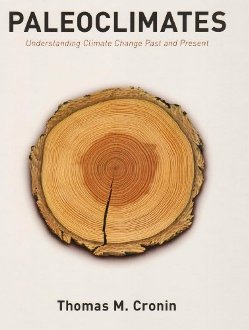
Paleoclimates
Thomas M. Cronin
Published by: Columbia University Press
Publication date: 2010
ISBN: 978-0-231-14494-0 (hbk)
ISBN: 978-0-231-51636-5 (ebook)
List price: £61.75
441 pp
www.cup.columbia.edu
In the months since the publication of the University of East Anglia CRU emails, there has been renewed debate about whether humankind is responsible for ostensible global warming. Thomas Cronin’s comprehensive study is therefore timely, applying great erudition even-handedly around a very vexed topic. His key perspective appears on page 298: “Recent studies of LIA (Little Ice Age) climate have taken two equally important approaches leading to differing opinions on its climatic significance. These can be called, for want of better terms, the geographical and geological approaches. The geological approach is “forward-looking,” starting from the perspective of long-term climate variability…..The geographical approach “looks back” at the LIA from the standpoint of the 20th and 21st centuries and is adopted mainly by specialists in geography and climatology, including tree-ring experts”.
Following a thorough discussion of the scope and methods of paleoclimatology Cronin describes the range of climatological evidence found in the geological record, extending from 3.8 billion years ago through the Cenozoic Era. He then sets the scene for subsequent events, describing significant changes in the Earth’s orbit. The discussion of glacial and Holocene variability is comprehensive, detailed, and places the evolving climate of the Anthropocene in an appropriate long-term context.
Chapter 11 provides a balanced discussion of the current controversy, examining forensically the roles of solar forcing, volcanic forcing and greenhouse gases. “Growing evidence … suggests that there is ‘anomalous behaviour’ in some segments of the climate system but great uncertainty surrounding others. Climate response over the past millennium is regionally variable in scale and sign (warming in one region, cooling in another) and often asynchronous because of feedbacks”.
Taken within the more extensive context, the geological approach points to firm evidence for a warm but regionally complex MWP (Medieval Warm Period). There were multiple temperature minima during the global LIA climate anomaly, although there was inter-hemispheric asymmetry. For instance southern hemisphere warming is seen in LIA ice-core records from the Antarctic peninsula at times when the northern hemisphere cooled.
The geographical approach, which uses tree-ring proxies, is handicapped by the relatively few annually resolved records older than 400 years, so it is considered premature to use these to establish temperatures over the entire 1000 years. Additionally, tree-ring reconstructions of temperature during the late 20th century that show cooling, or no change, fail to reflect the warming seen in instrumental records.
Chapter 12 reviews the range of climatic and hydrological change of the past 2000 years. Commenting on the IPCC report, the author notices its lack of sufficient late Holocene proxy records. He says that compelling evidence exists for anomalous 20th Century climatic patterns in some instances. In others, pre-industrial decadal-to-centennial scale variability complicates any effort to quantify human-induced impacts.
There follows discussion of certain factors that would reflect the combined impacts of inherent climate variability and greenhouse gas forcing: precipitation and drought, tropical cyclone activity and changes in ocean temperature, circulation and chemistry. This section concludes with a review of polar regions, glaciers, sea ice and their effect on sea level if widespread melting continues.
In conclusion, Professor Cronin considers that some evidence suggests that 20th Century climate behaviour is anomalous in relation to that constructed from proxies over centuries or longer. This suggests at least some human influence on the non-temperature parts of the climate system. Other records show significant decadal to centennial climate variability caused by external forcing. The amplitude of pre-industrial variability can equal or exceed that seen in the recent instrumental record. Climate variability during the MWP and LIA was especially large, but the causes are only partially understood.
Paleoclimates was completed just before the controversy at UEA erupted, so I find that it shuffles somewhat in the author’s attempts to avoid stepping on academic toes. This style imparts faithfully the rather stultifying atmosphere that existed in climate science before the CRU emails smashed open a window and let in the fresh air of fully objective enquiry. In this respect this otherwise excellent book brought to my mind the concluding remarks of Ian Strangeway (2010) in Measuring Global Temperatures (Cambridge University Press): “I am aware that by stressing the complexity of the climate system, the uncertainty of the measurements and the intricacy of what they show, I run the risk of offending the committed environmentalist and possibly encouraging the sceptics. I sit in the middle, unhappy with the often petulant tone of the sceptics but also unable to support the appearance of certainty and simplicity that many climatologists try to convey. We have a long way to go yet”.
Malcolm McClure